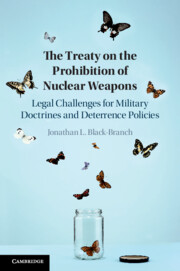 The Treaty on the Prohibition of Nuclear Weapons
The Treaty on the Prohibition of Nuclear Weapons Book contents
- The Treaty on the Prohibition of Nuclear Weapons
- Reviews
- The Treaty on the Prohibition of Nuclear Weapons
- Copyright page
- Contents
- Foreword
- Preface
- Acknowledgments
- Abbreviations
- 1 Changing the Status Quo in Nuclear Arms Control Law: The Treaty on the Prohibition of Nuclear Weapons 2017
- 2 Adopting the Treaty on the Prohibition of Nuclear Weapons 2017: A New Dawn, a New Deal, a New Direction in Nuclear Disarmament Law?
- 3 Humanitarian Nuclear Disarmament: Challenging the Status Quo through New Approaches to Legal Process, Purpose and Provisions
- 4 Legal Congruence with Existing Treaty Obligations: Toward Complementary or Competing Interests?
- 5 Customary International Law, Opinio Juris and State Practice Regarding the Treaty on the Prohibition of Nuclear Weapons 2017: Toward Universality?
- 6 Treaty Safeguards, Verification and Implementation: A Simple-Ban Approach and a Need for Oversight
- 7 Nuclear Deterrence Policies and the Prohibition Treaty: Disarmament Considerations
- 8 Nuclear Defense Doctrines: Disarmament and Emerging Humanitarian Concerns
- 9 Competition, Fragmentation and Polarization: A Bifurcated International Legal Infrastructure Regarding the Nuclear Architecture and Regulation?
- 10 Stigmatization-Action and Changing Global Perceptions to Delegitimize and Eliminate Nuclear Weapons
- 11 Toward Neo-Universalism: Toward a New Reality in International Law?
- 12 Obligations Erga Omnes: The Missing Link for Nuclear Nonproliferation and Disarmament Compliance
- 13 The Treaty on the Prohibition of Nuclear Weapons within the Nuclear Nonproliferation and Security Architecture in International Law: From Grand Bargain to Grand Challenges with the Right to Nuclear Peace and Freedom from Nuclear Fear: Summaries and Conclusions
- Index
13 - The Treaty on the Prohibition of Nuclear Weapons within the Nuclear Nonproliferation and Security Architecture in International Law: From Grand Bargain to Grand Challenges with the Right to Nuclear Peace and Freedom from Nuclear Fear: Summaries and Conclusions
Published online by Cambridge University Press: 17 April 2021
- The Treaty on the Prohibition of Nuclear Weapons
- Reviews
- The Treaty on the Prohibition of Nuclear Weapons
- Copyright page
- Contents
- Foreword
- Preface
- Acknowledgments
- Abbreviations
- 1 Changing the Status Quo in Nuclear Arms Control Law: The Treaty on the Prohibition of Nuclear Weapons 2017
- 2 Adopting the Treaty on the Prohibition of Nuclear Weapons 2017: A New Dawn, a New Deal, a New Direction in Nuclear Disarmament Law?
- 3 Humanitarian Nuclear Disarmament: Challenging the Status Quo through New Approaches to Legal Process, Purpose and Provisions
- 4 Legal Congruence with Existing Treaty Obligations: Toward Complementary or Competing Interests?
- 5 Customary International Law, Opinio Juris and State Practice Regarding the Treaty on the Prohibition of Nuclear Weapons 2017: Toward Universality?
- 6 Treaty Safeguards, Verification and Implementation: A Simple-Ban Approach and a Need for Oversight
- 7 Nuclear Deterrence Policies and the Prohibition Treaty: Disarmament Considerations
- 8 Nuclear Defense Doctrines: Disarmament and Emerging Humanitarian Concerns
- 9 Competition, Fragmentation and Polarization: A Bifurcated International Legal Infrastructure Regarding the Nuclear Architecture and Regulation?
- 10 Stigmatization-Action and Changing Global Perceptions to Delegitimize and Eliminate Nuclear Weapons
- 11 Toward Neo-Universalism: Toward a New Reality in International Law?
- 12 Obligations Erga Omnes: The Missing Link for Nuclear Nonproliferation and Disarmament Compliance
- 13 The Treaty on the Prohibition of Nuclear Weapons within the Nuclear Nonproliferation and Security Architecture in International Law: From Grand Bargain to Grand Challenges with the Right to Nuclear Peace and Freedom from Nuclear Fear: Summaries and Conclusions
- Index
Summary
The TPNW represents an unprecedented departure from current practice in that it is the first multilateral treaty to ban nuclear weapons. It is supported by 122 nations, representing a sizable contingent of the world’s population spanning various geographical divides. Although not celebrated by all nations, and vehemently opposed by nuclear-weapon states, its adoption at the UN General Assembly in July 2017 marks a fundamental departure from the status quo regarding armament matters. The primary purpose of this book was to examine the TPNW within the broader legal, diplomatic and political context in relation to the existing nuclear nonproliferation and disarmament framework in international law, exploring the influence of the Treaty from various perspectives and its potential impact on the nuclear architecture as it stands today.
Keywords
- Type
- Chapter
- Information
- The Treaty on the Prohibition of Nuclear WeaponsLegal Challenges for Military Doctrines and Deterrence Policies, pp. 377 - 413Publisher: Cambridge University PressPrint publication year: 2021
